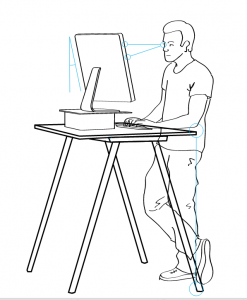0800 011 4531
Call FREE: Mon-Thu: 08:30-17:00 Friday: 08:30-16:00
It’s no big secret that our health affects us both physically and mentally. A large amount of research has been done on health factors in the work place, including common health problems at work, the lack of exercise caused by today’s 9-5 sit-down culture and how exercise has a positive impact on our brain.
Scientific research has proven that health and happiness are intrinsically linked. Frequent exercise has the obvious effect of improving our health through lowering blood pressure and managing weight. However, exercise also has a significant mental impact on our brains, reducing stress and stimulating the production of endorphins – known as the ‘happy’ hormone. Depression and stress are major factors which can negatively impact productivity in the work place, and, for the most part, can be largely combated through regular exercise. So how can businesses encourage employees to take up regular exercise? Take Action: Keep your employees running like a well-oiled machine by implementing a gym membership subsidy, encouraging employees to take up regular exercise.  Encouraging employees to adapt to a healthier lifestyle, and essentially improving employee welfare, is a fundamental approach which should be built into every businesses mission. Remember - a small investment in the wellbeing of your staff can lead to long term gains. Featured Expert: “Even if you work long hours there’s usually a way that you can fit 20-30 minutes of exercise into your day. For many people it’s just a case of getting up a bit earlier. Some of my best ideas come to me while I’m exercising and the extra energy I get from exercising regularly definitely helps me get more work done.” - Julia Buckley - Health and fitness expert
Encouraging employees to adapt to a healthier lifestyle, and essentially improving employee welfare, is a fundamental approach which should be built into every businesses mission. Remember - a small investment in the wellbeing of your staff can lead to long term gains. Featured Expert: “Even if you work long hours there’s usually a way that you can fit 20-30 minutes of exercise into your day. For many people it’s just a case of getting up a bit earlier. Some of my best ideas come to me while I’m exercising and the extra energy I get from exercising regularly definitely helps me get more work done.” - Julia Buckley - Health and fitness expert
Staff absence due to illness can amount to an enormous long term expense to businesses. According to a study by accountancy firm PwC, workers in the UK take, on average, 9 sick days a year - this amounts to a total estimated cost of £29 billion to UK businesses every year.
"At a time when companies are striving for growth, it is vital they address this cost by looking for ways to improve employees' health, morale and motivation” HR Consultant Jon Andrews
In order to escape the costs of high absenteeism levels, businesses should invest in their employees’ wellbeing, whether this is by providing access to private healthcare, stocking only healthy foods in the office canteen, no matter how big or small, each step taken is one in the right direction.
Fact: The NHS recommends drinking between 8-10 glasses of water a day to maintain health, replace fluids and help our bodies eliminate toxins and waste – keeping you healthy. Encourage this by investing in an office water cooler keeping your team well hydrated throughout the day.
There’s significant evidence that keeping employees active in the workplace is beneficial to their health and your business. Startling statistics from the World Health Organisation (WHO) reveal that over 3 million deaths occur each year, due to insufficient physical activity. These figures are obviously a worst case scenario, but they highlight the importance of keeping active and escaping today’s sedative lifestyle. Featured Expert: “Every hour, get up from your desk and move. Whether it is walking to get a glass of water or just having a bit of a stretch. Also, instead of sending an email to a colleague across the room to ask them a question, get up and walk over. Sitting down all day is not good for you.” Dannii Martin – Health and fitness blogger at hungryhealthyhappy.com Modern office environments present an unnatural and unhealthy environment in which people sit at a desk and remain inactive for the majority of the day. Although time saving technologies such as internal email or in-office Skype chats may shave minutes off employee time, the long term costs are a risk to employee health by encouraging inactivity. Businesses are taking a leaf out of the history book when trying to keep their employees more active during the 9 to 5. Before the invention of email or phones, people had to walk across the office if they wanted to ask a question or talk about a piece of work. Take Action: Ban all non-essential internal communications via email or phone. This will mean that staff actually have to get up and physically move to speak with colleagues. To further enhance physical activity, remove chairs from meeting rooms. ‘Stand-up’ style meetings have been proven to encourage engagement and contribution – being on your feet is just an added health bonus. Recently, there has been a growth in the popularity of sit-stand desks, these adjustable desks provide the ideal solution to the ‘sitting epidemic’, allowing employees to raise their desk to standing height and work on their feet. This ergonomic innovation keeps employees active. Unfortunately, these desks can be considerably more expensive, costing in excess of £400 each – making them a sizeable long-term business investment.
 Image by Mattthew Brauer
Image by Mattthew Brauer
Software firm, VM Turbo, saw great success with the introduction of standing desks, with employees reportedly now spending 70% of their day in a physically active state. The desks have proven extremely popular with their employees, with nobody on the team wishing to revert to old style sitting desks. These changes may seem small when examined individually, however, they can add up to a significant increase in physical activity when combined over a long period of time.
